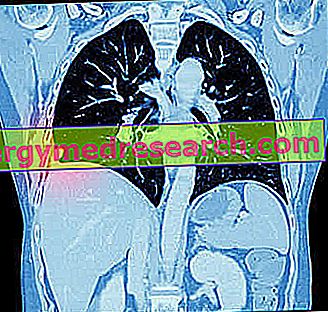Generality
Buprenorphine is a semi-synthetic drug belonging to the class of opioid analgesics. It is a derivative of thebaine, a natural alkaloid that is extracted from the opium poppy.

Buprenorphine - Chemical Structure
Buprenorphine is a partial opioid receptor agonist used to treat pain and - compared to other opioid painkillers - can cause less severe respiratory depression, tolerance and dependence.
Furthermore, buprenorphine is also used in the treatment of opioid cessation.
Examples of medicinal specialties containing Buprenorphine
- Buprenorphine - Generic Drug
- Buprenorphine Molteni ®
- Buprenorphine Sun ®
- Suboxone ® (in combination with naloxone).
- Subutex ®
- Temgesic ®
- Transtec ®
Indications
For what it uses
The use of buprenorphine is indicated for the treatment of pain (both acute and chronic) from moderate to severe and of different origin and nature (including pain caused by neoplastic diseases).
Furthermore, buprenorphine is used in opioid cessation programs in adults and adolescents over 15 years of age.
Warnings
Because buprenorphine can cause respiratory failure, the drug should be used very cautiously in patients with lung disease.
Buprenorphine should be used with caution also in patients suffering from the following diseases:
- Viral hepatitis, biliary tract dysfunction or other liver disorders;
- Impaired renal function;
- Mixedema or hypothyroidism;
- Addison's disease;
- Hypotension;
- Toxic psychosis;
- Prostatic hypertrophy or urethral stricture;
- Brain affections accompanied by increased intracranial pressure.
Since buprenorphine can induce tolerance and dependence, it is necessary to take all necessary precautions so that patients do not abuse or improperly use the drug. In fact, buprenorphine therapy must be performed under the strict supervision of a doctor.
Buprenorphine can trigger withdrawal symptoms in individuals with strong opioid dependence, but it suppresses them in individuals who are interrupting the use of these substances (which is why it can be used in opioid cessation therapy).
Buprenorphine may alter the ability to drive and / or use machinery, so extreme caution should be used.
For those who play sports, the use of buprenorphine without therapeutic necessity is doping and in any case can determine positivity to doping tests even when the drug is taken for therapeutic purposes.
Interactions
Consumption of alcohol and / or alcohol- containing medicines should be avoided during treatment with buprenorphine. This is because alcohol is able to enhance the effects of buprenorphine.
Concomitant administration of buprenorphine and benzodiazepines should be avoided - or at least under the strict supervision of a physician - as this combination can cause respiratory depression to death.
Before starting treatment with buprenorphine, you must tell your doctor if you are already taking other medicines that can depress the central nervous system, as this could lead to dangerous and excessive central depression. These drugs include:
- Other opioid analgesics ;
- Some types of anesthetics ;
- Some anxiolytics ;
- Hypnotic sedatives ;
- Some antitussives ;
- Some types of antidepressant drugs;
- Antihistamines ;
- Barbiturates ;
- Antipsychotics ;
- Clonidine and other similar drugs.
Buprenorphine should not be used in patients who are taking - or have taken in the last two weeks - monoamine oxidase inhibitor (MAOI) drugs.
Concomitant administration of buprenorphine and the following medications may increase the effects of buprenorphine itself:
- Antivirals used for the treatment of HIV, such as, for example, ritonavir;
- Macrolides, antibiotic drugs;
- Azole antifungals, such as, for example, ketoconazole, itraconazole, etc.;
- Gestodene, a progestin used as a contraceptive;
- Oral anticoagulants ;
- Halothane, a general anesthetic.
The effects of buprenorphine can be reduced, instead, by the concomitant administration of phenobarbital, carbamazepine, phenytoin (antiepileptic drugs) and rifampicin (an antibiotic used in tuberculosis therapy).
However, it is still a good idea to tell your doctor if you are taking - or have recently taken - any type of medication, including over-the-counter medicines and herbal and homeopathic products.
Side effects
Buprenorphine can cause different types of adverse effects, but not all patients experience them.
The following are some of the major side effects that may occur during buprenorphine treatment.
Nervous system disorders
Buprenorphine therapy can cause:
- Headache;
- dizziness;
- Sedation;
- Difficulty concentrating;
- Speech disorders;
- Numbness;
- Burning sensation or tingling;
- Dizziness;
- Convulsions;
- Coma.
Psychiatric disorders
Treatment with buprenorphine may cause:
- Euphoria;
- Depression;
- Confusion;
- Restlessness;
- Sleep disorders;
- Anxiety;
- Nightmares;
- Decrease in libido.
Cardiovascular disorders
Buprenorphine therapy can promote the onset of hypotension or hypertension, tachycardia or bradycardia, orthostatic hypotension and circulatory collapse.
Gastrointestinal disorders
Treatment with buprenorphine can cause nausea, vomiting, heartburn and constipation.
Skin and subcutaneous tissue disorders
In the course of buprenorphine therapy may occur:
- Redness of the skin;
- Itch;
- Exanthema (especially after long periods of treatment);
- Sweating;
- Skin eruptions.
Other side effects
Other side effects that may occur during treatment with buprenorphine are:
- Tolerance and dependence;
- Allergic reactions in sensitive individuals;
- Visual and miosis disorders;
- Tinnitus;
- Urinary retention and urination disorders;
- Difficulty of erection;
- Dysmenorrhea;
- Edema;
- Weakness;
- Reactions at the site of administration (when the drug is administered parenterally or topically).
Overdose
The symptoms that can appear when taking excessive doses of buprenorphine are:
- Miosi;
- Sedation;
- Hypotension;
- Nausea and vomit;
- Respiratory depression up to respiratory arrest;
- Cardiovascular collapse;
- Death.
The antidote for buprenorphine overdose is naloxone.
In any case, if you suspect a overdose, you must contact your doctor immediately and contact the nearest hospital.
Action mechanism
Buprenorphine is a partial agonist of the μ and κ opioid receptors.
These receptors are located along the pain pathways present in our body and their task is precisely to modulate the neurotransmission of painful stimuli. More precisely, when these receptors are stimulated there is induction of analgesia.
Buprenorphine, therefore - as a partial agonist - is able to activate the μ and κ receptors, thus inducing analgesia.
Furthermore, the fact that buprenorphine is a partial agonist of such receptors, also allows its use in opioid cessation therapy to reduce symptoms caused by withdrawal syndrome.
Mode of Use - Posology
Buprenorphine is available for oral administration (in the form of sublingual tablets), for parenteral administration (in the form of an injectable solution) and for topical administration (in the form of a transdermal patch).
During treatment with buprenorphine - to avoid the occurrence of dangerous side effects and to avoid the development of tolerance and dependence - it is essential to follow the doctor's instructions, both as regards the amount of drug to be taken, and as regards the frequency of the administrations and the duration of the same treatment.
In the following, some indications will be given on the doses of buprenorphine usually used in therapy.
Pain treatment
For pain treatment, parenteral buprenorphine is usually used. The usual dose used in adults is 0.3-0.6 mg of drug, to be administered intramuscularly or slowly intravenously every 6-8 hours, or as needed.
Alternatively, the buprenorphine-based transdermal patch can be used. This particular pharmaceutical formulation is used above all for the treatment of pain caused by neoplastic diseases. The transdermal patches based on buprenorphine are available in different dosages and allow the gradual release of the drug over time.
The patch usually has a duration of action of four days, therefore, it is recommended to apply one patch at a time and replace it after this period. Notwithstanding that, in any case, the instructions provided by the doctor must be followed.
Since there are insufficient data on the safe use of the buprenorphine-based transdermal patch in children and adolescents under 18 years of age, its use in this category of patients is not recommended.
Opioid cessation
In the treatment of opioid cessation buprenorphine is used in the form of sublingual tablets.
The dose of the drug must be established by the doctor. Usually, therapy is started with small amounts of the drug that will be gradually increased by the doctor until the optimal dosage is reached.
Pregnancy and breastfeeding
Generally, the use of buprenorphine during pregnancy is not recommended (especially during the last period), this because the drug can cause respiratory depression and withdrawal syndrome (especially if the pregnant woman has made chronic use of it).
Furthermore, buprenorphine is excreted in breast milk, therefore its use is also contraindicated during breastfeeding.
Contraindications
The use of buprenorphine is contraindicated in the following cases:
- In patients with known hypersensitivity to buprenorphine itself;
- In patients with dependence on other opioid analgesics (only in the case of buprenorphine-based pharmaceutical preparations with specific indications for the treatment of pain);
- In patients with respiratory failure;
- In patients with acute alcoholism or delirium tremens;
- In patients who take - or who have recently taken - IMAO;
- In patients with liver failure;
- In patients with myasthenia gravis;
- Pregnant;
- During breastfeeding.
Furthermore, when buprenorphine is used for the treatment of pain, its use is contraindicated in children under 12 years of age. When, on the other hand, buprenorphine is used in the treatment of opioid withdrawal, its use is contraindicated in adolescents under 15 years of age.



